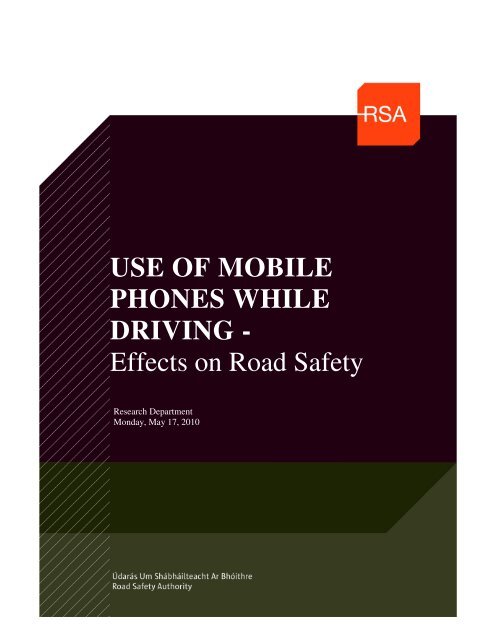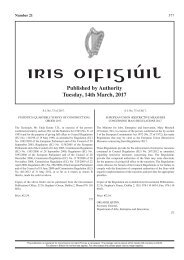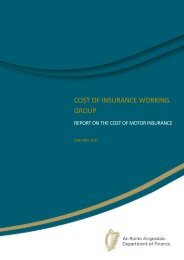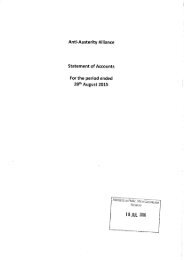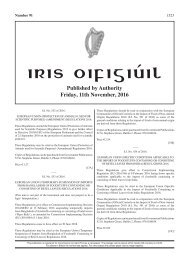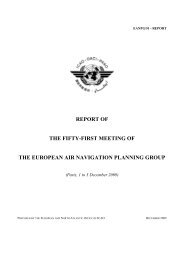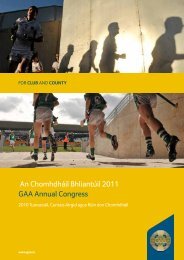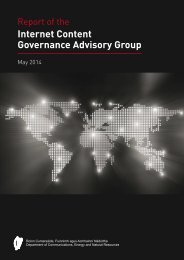USE OF MOBILE PHONES WHILE DRIVING - Effects on Road Safety
USE OF MOBILE PHONES WHILE DRIVING - Effects on Road Safety
USE OF MOBILE PHONES WHILE DRIVING - Effects on Road Safety
You also want an ePaper? Increase the reach of your titles
YUMPU automatically turns print PDFs into web optimized ePapers that Google loves.
<str<strong>on</strong>g>USE</str<strong>on</strong>g> <str<strong>on</strong>g>OF</str<strong>on</strong>g> <str<strong>on</strong>g>MOBILE</str<strong>on</strong>g><br />
<str<strong>on</strong>g>PHONES</str<strong>on</strong>g> <str<strong>on</strong>g>WHILE</str<strong>on</strong>g><br />
<str<strong>on</strong>g>DRIVING</str<strong>on</strong>g> -<br />
<str<strong>on</strong>g>Effects</str<strong>on</strong>g> <strong>on</strong> <strong>Road</strong> <strong>Safety</strong><br />
Research Department<br />
M<strong>on</strong>day, May 17, 2010
Use of mobile ph<strong>on</strong>es while driving – <str<strong>on</strong>g>Effects</str<strong>on</strong>g> <strong>on</strong> <strong>Road</strong> <strong>Safety</strong><br />
Table of C<strong>on</strong>tents<br />
Introducti<strong>on</strong> .............................................................................................................................. 3<br />
Driver Distracti<strong>on</strong> .................................................................................................................... 3<br />
Collisi<strong>on</strong> Risk ............................................................................................................................ 3<br />
<str<strong>on</strong>g>Effects</str<strong>on</strong>g> of mobile ph<strong>on</strong>e use <strong>on</strong> driving performance ........................................................... 3<br />
Mobile ph<strong>on</strong>e use and drink driving ...................................................................................... 4<br />
Mobile ph<strong>on</strong>e use – c<strong>on</strong>versati<strong>on</strong> with a passenger – listening to music............................. 4<br />
Legislati<strong>on</strong> ................................................................................................................................. 5<br />
Effectiveness of Interventi<strong>on</strong>s to Reduce Mobile Ph<strong>on</strong>e Usage While Driving .................. 5<br />
Texting ...................................................................................................................................... 5<br />
References ................................................................................................................................. 6<br />
Appendix 1 ................................................................................................................................ 9
Use of mobile ph<strong>on</strong>es while driving – <str<strong>on</strong>g>Effects</str<strong>on</strong>g> <strong>on</strong> <strong>Road</strong> <strong>Safety</strong><br />
Introducti<strong>on</strong><br />
This report focuses <strong>on</strong> the effect of mobile ph<strong>on</strong>e <strong>on</strong> driving performance and road safety. It<br />
is a short review of the research carried out <strong>on</strong> the subject. There are a large numbers of<br />
research sources <strong>on</strong> the topic. The research department in the <strong>Road</strong> <strong>Safety</strong> Authority has over<br />
a hundred research papers. The topic is also well referenced in all current traffic and<br />
transport safety publicati<strong>on</strong>s (Cartt, Hellinga, & Bratiman, 2006). While there is ever<br />
increasing focus <strong>on</strong> driver distracti<strong>on</strong>, and its role in increasing collisi<strong>on</strong> risk for road users,<br />
the evidence is relatively str<strong>on</strong>g that mobile use by drivers, whether hand free or hand held, is<br />
major c<strong>on</strong>tributory factor in increasing distracti<strong>on</strong> that can lead to increased collisi<strong>on</strong> risk.<br />
Driver Distracti<strong>on</strong><br />
Driver distracti<strong>on</strong> is thought to play a role in 20-30% of all road collisi<strong>on</strong>s. (Dews & Stayer,<br />
2009).Distracti<strong>on</strong> is caused by a competing activity, event or object from inside or outside the<br />
vehicle. <strong>Safety</strong> problems related to driver distracti<strong>on</strong> are escalating as more technologies<br />
become available for use in motorized vehicles. Such a technology, already widely available<br />
and accepted, is the mobile ph<strong>on</strong>e. At the end of December 2009 there were 5,302,345<br />
mobile subscripti<strong>on</strong>s in Ireland (ComReg, 2009). While it is clear that mobile ph<strong>on</strong>es<br />
enhance business communicati<strong>on</strong> and increase pers<strong>on</strong>al c<strong>on</strong>venience, use of mobile ph<strong>on</strong>es<br />
while driving has become a road safety c<strong>on</strong>cern.<br />
The vast majority of drivers (39 % to 45%) report using their mobile ph<strong>on</strong>e at least<br />
sometimes while driving, and it is estimated that at any given moment during the day, 2 to<br />
6% of the drivers is using a mobile ph<strong>on</strong>e (<strong>Road</strong> <strong>Safety</strong> Authority, 2010).<br />
The mobile ph<strong>on</strong>e distracts drivers in two ways: it causes physical distracti<strong>on</strong> and cognitive<br />
distracti<strong>on</strong>. Physical distracti<strong>on</strong> occurs when drivers have to simultaneously operate their<br />
mobile ph<strong>on</strong>e (i.e. reach, dial, hold) and operate their vehicle. Cognitive distracti<strong>on</strong> occurs<br />
when a driver has to divert part of his/her attenti<strong>on</strong> from driving to the teleph<strong>on</strong>e<br />
c<strong>on</strong>versati<strong>on</strong>. However, the ability to divide <strong>on</strong>e’s attenti<strong>on</strong> between two simultaneous tasks<br />
is limited.<br />
Collisi<strong>on</strong> Risk<br />
Mobile ph<strong>on</strong>e use while driving could therefore negatively affect driving performance.<br />
The results of epidemiological studies str<strong>on</strong>gly suggest that using a mobile ph<strong>on</strong>e while<br />
driving can increase the risk of being involved in a road collisi<strong>on</strong> up to four times.<br />
Probably the most famous and most frequently cited epidemiological study about the risks of<br />
mobile ph<strong>on</strong>e use while driving is the study of Redelmeier and Tibshirani (Redelemeir &<br />
Tibshirani, 1997). The researchers found that the risk of a collisi<strong>on</strong> when using a mobile<br />
ph<strong>on</strong>e was four times higher than the risk when a mobile teleph<strong>on</strong>e was not being used. The<br />
results of the study also suggested that hands-free ph<strong>on</strong>es offered no safety advantage over<br />
handheld units. Similar findings were achieved in other epidemiological studies (Laberge-<br />
Nadau, et al., 2003), (McEvoy, et al., 2005),<br />
<str<strong>on</strong>g>Effects</str<strong>on</strong>g> of mobile ph<strong>on</strong>e use <strong>on</strong> driving performance<br />
What are the reas<strong>on</strong>s for this four-fold increase in the risk of having a road collisi<strong>on</strong> when<br />
using a mobile ph<strong>on</strong>e? What makes a mobile ph<strong>on</strong>e so dangerous when used in a vehicle?
Use of mobile ph<strong>on</strong>es while driving – <str<strong>on</strong>g>Effects</str<strong>on</strong>g> <strong>on</strong> <strong>Road</strong> <strong>Safety</strong><br />
Mobile ph<strong>on</strong>es potentially distract driver in several ways:<br />
1. Physically: instead of focusing <strong>on</strong> the physical tasks required by driving (e.g. steering,<br />
gear changing), drivers have to use <strong>on</strong>e or both of their hands to manipulate the ph<strong>on</strong>e.<br />
2. Visually: mobile ph<strong>on</strong>es could visually distract drivers in two ways:<br />
− Firstly, drivers have to move their eyes from the road and focus <strong>on</strong> the mobile ph<strong>on</strong>e<br />
in order to be able to use it.<br />
− Sec<strong>on</strong>dly, while talking <strong>on</strong> a mobile ph<strong>on</strong>e, even if drivers’ eyes are focused <strong>on</strong> the<br />
road, they 'look but do not see'.<br />
3. Auditory: the focus of drivers' attenti<strong>on</strong> moves from the road envir<strong>on</strong>ment to the<br />
sounds of the mobile ph<strong>on</strong>e and the c<strong>on</strong>versati<strong>on</strong>. This particularly applies when the<br />
sound quality is poor.<br />
4. Cognitively: instead of focusing their attenti<strong>on</strong> and thoughts <strong>on</strong> driving, drivers divert<br />
their attenti<strong>on</strong> and focus <strong>on</strong> the topic of the ph<strong>on</strong>e c<strong>on</strong>versati<strong>on</strong> (Dragutinovic & Twisk,<br />
2005).<br />
A large number of studies have shown that using a mobile ph<strong>on</strong>e (a cognitive task) while<br />
driving degrades driving performance, (Parkes & Hooijmeijer, 2000), (Haigney, Taylor, &<br />
Westerman, 2000) (Strayer, Drews, & Johnst<strong>on</strong>, 2003) (Strayer & Johnst<strong>on</strong>, 2001),<br />
(C<strong>on</strong>siglio, Driscoll, Witte, & Berg, 2003) (Rakauskas, Gugerty, & Ward, 2004) (Tornros &<br />
Bolling, 2005) (Cooper, Zheng, Christian, Vavrik, Heinrichs, & Siegmund, 2003) (Hancock,<br />
Lesch, & Simm<strong>on</strong>s, 2003) (Patten, Kircher, Ostlund, & Nilss<strong>on</strong>, 2004) (Liu & Lee, 2005),<br />
(Just, Keller, & Cynkar, 2008). (Caird, Willness, Steel, & Scialfa, 2008), (Hamada, 2008),<br />
Mobile ph<strong>on</strong>e use and drink driving<br />
The comparis<strong>on</strong> of mobile ph<strong>on</strong>es with alcohol impairment c<strong>on</strong>tinues to attract researchers<br />
because of the already established thresholds and risks for alcohol impairment. In 2002, a<br />
study by the Transport Research Laboratory in the UK found that while driving while<br />
intoxicated is clearly impaired, certain aspects of driving performance are even more<br />
impaired by mobile ph<strong>on</strong>e use. (Burns, Parkes, Burt<strong>on</strong>, Smith, & Burch, 2002). A similar<br />
study in 2006 that mobile-ph<strong>on</strong>e drivers may exhibit greater impairments than intoxicated<br />
drivers. (Strayer, Drews, & Crouch, 2006). However it should be noted that both studies<br />
found that length of impairment was obviously far less for the mobile ph<strong>on</strong>e users.<br />
Mobile ph<strong>on</strong>e use – c<strong>on</strong>versati<strong>on</strong> with a passenger – listening to music<br />
C<strong>on</strong>versati<strong>on</strong>s with passengers in the real world are self-paced in c<strong>on</strong>trast to ph<strong>on</strong>e<br />
c<strong>on</strong>versati<strong>on</strong>s. Ph<strong>on</strong>e c<strong>on</strong>versati<strong>on</strong>s are generally deliberately initiated c<strong>on</strong>versati<strong>on</strong>s and,<br />
compared with a c<strong>on</strong>versati<strong>on</strong> with a passenger, are more purposeful and goal-directed with a<br />
faster exchange of informati<strong>on</strong>. Because the passenger is present during the whole journey, a<br />
c<strong>on</strong>versati<strong>on</strong> with a passenger can be c<strong>on</strong>ducted in a less urgent manner. In the case of a<br />
passenger c<strong>on</strong>versati<strong>on</strong>, the passenger is also aware of the driving situati<strong>on</strong> and can<br />
sometimes even help draw attenti<strong>on</strong> to dangerous situati<strong>on</strong>s. In the case of a mobile ph<strong>on</strong>e<br />
c<strong>on</strong>versati<strong>on</strong>, the other pers<strong>on</strong> is generally not even aware that his/her c<strong>on</strong>versati<strong>on</strong> partner is<br />
driving, (Dragutinovic & Twisk, 2005). In a study in 2005 it was found that the normal<br />
c<strong>on</strong>versati<strong>on</strong>s with a passenger were suppressed <strong>on</strong> the most demanding urban roads, for both<br />
driver and passenger. On the other hand, the mobile ph<strong>on</strong>e c<strong>on</strong>versati<strong>on</strong> prevented<br />
suppressi<strong>on</strong> from occurring in the passengers’ c<strong>on</strong>versati<strong>on</strong>s and even encouraged drivers to
Use of mobile ph<strong>on</strong>es while driving – <str<strong>on</strong>g>Effects</str<strong>on</strong>g> <strong>on</strong> <strong>Road</strong> <strong>Safety</strong><br />
make more utterances that they would normally do in a normal passenger c<strong>on</strong>versati<strong>on</strong><br />
(Crundall, Bains, Chapman, & Underwood, 2005).<br />
Two studies comparing the effects of using a mobile ph<strong>on</strong>e and listening to music in vehicles.<br />
The studies c<strong>on</strong>cluded that the distracti<strong>on</strong> of listening to music was far less that using a<br />
mobile ph<strong>on</strong>e. (C<strong>on</strong>siglio, Driscoll, Witte, & Berg, 2003), (Strayer & Johnst<strong>on</strong>, 2001)<br />
Legislati<strong>on</strong><br />
Most EU countries have introduced legislati<strong>on</strong> aimed at restricting the use of mobile ph<strong>on</strong>es.<br />
The most comm<strong>on</strong> legislative measure is the ban <strong>on</strong> hand-held ph<strong>on</strong>es while driving a<br />
vehicle. Other measures include prohibiting the use of mobile ph<strong>on</strong>es – both hand-held and<br />
hands-free for special categories of drivers (e.g. school bus drivers) or young drivers, usually<br />
within the framework for a graduated licensing system,(Breen C<strong>on</strong>sulting, 2009). The use of<br />
hand-held mobile ph<strong>on</strong>es while driving is illegal in over 40 countries (see appendix 1); most<br />
EU countries, Australia, and <strong>on</strong>e Canadian province and the United States.<br />
Effectiveness of Interventi<strong>on</strong>s to Reduce Mobile Ph<strong>on</strong>e Usage While Driving<br />
Evaluati<strong>on</strong>s of the effectiveness of the banning of mobile ph<strong>on</strong>e usage while driving have<br />
been carried out in Japan (ROSPA, 2002), Finland (Rajalin, Summala, Poysti, Anteroinen, &<br />
Porter, 2005), some US states (McCartt, Braver, & Geary, 2003) (McCartt & Geary, 2004)<br />
and in the United Kingdom (Broughan & Hill, 2004). Regarding the effectiveness of the ban<br />
<strong>on</strong> the use of handheld mobile ph<strong>on</strong>es, these studies show short-term effects of up to a 50%<br />
reducti<strong>on</strong> of use, but the l<strong>on</strong>g-term effects are far less positive. The two studies in the US<br />
found that <strong>on</strong>e year after the introducti<strong>on</strong> of a ban; the use in the State of New York went<br />
back to the same level as before the law (McCartt et al., 2003; McCartt & Geary, 2004).<br />
Texting<br />
Text messaging while driving has a negative impact <strong>on</strong> performance. This negative impact<br />
appears to exceed the impact of c<strong>on</strong>versing <strong>on</strong> a ph<strong>on</strong>e while driving. (Drews, Yazdani,<br />
Godfrey, & Cooper, 2009). These finding were supported in another study which found that<br />
retrieving, and in particular, sending text meassages has a detrimental effect <strong>on</strong> a number of<br />
safety critical driving measures. When text messaging, drivers’ ability to maintain their<br />
lateral positi<strong>on</strong> <strong>on</strong> the road and to detect and resp<strong>on</strong>d appropriately to traffic signs was<br />
significantly reduced. In additi<strong>on</strong>, drivers spent up to 400% more time with their eyes off the<br />
road when text messaging than when not texting messaging, (Hosking, Young, & Regan,<br />
2006). Other research <strong>on</strong> texting and driving are including in the following studies; (Nemme<br />
& White, 2010) (Reed & Parkes, 2008)
Use of mobile ph<strong>on</strong>es while driving – <str<strong>on</strong>g>Effects</str<strong>on</strong>g> <strong>on</strong> <strong>Road</strong> <strong>Safety</strong><br />
References<br />
Broughan, J., & Hil, J. P. (2004). Mobile Ph<strong>on</strong>e Use by Drivers 2000-2004. Crowthorne: Transport<br />
Research Laboratory.<br />
Burns, P. C., Parkes, A., Burt<strong>on</strong>, S., Smith, R. K., & Burch, D. (2002). How dangerous is driving with<br />
a mobile ph<strong>on</strong>e? Benchmarking the impairment to alcohol. Crowthorne.: Transport Research<br />
Laboratory.<br />
Caird, J. K., Willness, C. M., Steel, P., & Scialfa, C. (2008). A meta-analysis of the effects of cell<br />
ph<strong>on</strong>es <strong>on</strong> driver performance. Accident Analysis and Preventi<strong>on</strong> , 1282-1293.<br />
ComReg. (2009). Irish Communicati<strong>on</strong>s Market - Quarterly Key Data Report. Commissi<strong>on</strong> for<br />
Communicati<strong>on</strong>s Regulati<strong>on</strong>.<br />
C<strong>on</strong>siglio, W., Driscoll, P., Witte, M., & Berg, W. P. (2003). Effect of cellular teleph<strong>on</strong>e<br />
c<strong>on</strong>versati<strong>on</strong>s and other potential interface <strong>on</strong> reacti<strong>on</strong> time in a braking resp<strong>on</strong>se. Accident<br />
Analysis and Preventi<strong>on</strong> , 35, 495-500.<br />
C<strong>on</strong>sulting, J. B. (2009). Car Teleph<strong>on</strong>e Use and <strong>Road</strong> <strong>Safety</strong>. European Commissi<strong>on</strong>.<br />
Cooper, P. J., Zheng, Y., Christian, R., Vavrik, J., Heinrichs, B., & Siegmund, G. (2003). The impact<br />
of hands-free message recepti<strong>on</strong>/resp<strong>on</strong>se <strong>on</strong> driving task performance. Accident Analysis and<br />
Preventi<strong>on</strong> , 35, 23-35.<br />
Crundall, D., Bains, M., Chapman, P., & Underwood, G. (2005). Regulating c<strong>on</strong>versati<strong>on</strong> during<br />
driving: a problem for mobile teleph<strong>on</strong>es? Transportati<strong>on</strong> Research Part F, vol. 8, no. 3, p. 197-<br />
211. , 187-211.<br />
Dews, F. A., & Stayer, D. L. (2009). Cellular Ph<strong>on</strong>es and Driver Distracti<strong>on</strong>. In M. A. Regan, J. D.<br />
Lee, & K. L. Young, Driver Distracti<strong>on</strong> Theory, <str<strong>on</strong>g>Effects</str<strong>on</strong>g> and Mitigati<strong>on</strong> (pp. 169-190). CRC Press.<br />
Dragutinovic, N., & Twisk, D. (2005). Use of mobile ph<strong>on</strong>e while driving - effects <strong>on</strong> road safety.<br />
SWOV Institute for <strong>Road</strong> <strong>Safety</strong> Research The Netherlands.<br />
Drews, F. A., Yazdani, H., Godfrey, C. N., & Cooper, J. M. (2009). Text Messaging Druring<br />
Simulated Driving. Human Factors , 762-770.<br />
Haigney, D. E., Taylor, R. G., & Westerman, S. J. (2000). C<strong>on</strong>current mobile (cellular) ph<strong>on</strong>e use<br />
and driving performance; Tasks demand characteristics and compensatory processes.<br />
Transportati<strong>on</strong> research Part F , 3, 113.121.<br />
Hamada, T. (2008). Experimental analysis of interacti<strong>on</strong>s between 'where' and 'what' aspects of<br />
informati<strong>on</strong> in listening and driving; A possible cognitiove risk of using mobile ph<strong>on</strong>es during<br />
driving. Transportati<strong>on</strong> Research Part F , 75-82.<br />
Hancock, P. A., Lesch, M., & Simm<strong>on</strong>s, L. (2003). The distracti<strong>on</strong> effects of ph<strong>on</strong>e use during a<br />
crucial driving maneuver. Accident Analysis and Preventi<strong>on</strong>, vol. 35, no. 4, p. 501-514. , 501-514.
Use of mobile ph<strong>on</strong>es while driving – <str<strong>on</strong>g>Effects</str<strong>on</strong>g> <strong>on</strong> <strong>Road</strong> <strong>Safety</strong><br />
Hosking, S., Young, K., & Regan, M. (2006). The <str<strong>on</strong>g>Effects</str<strong>on</strong>g> of Tex Messaging <strong>on</strong> Young Novice Driver<br />
Performance. M<strong>on</strong>ash University Accident Research Centre (MUARC).<br />
Just, M. A., Keller, T. A., & Cynkar, J. (2008). A decrease in brain activity associated when driving<br />
when listening to some<strong>on</strong>e speak. Brain Research , 70-80.<br />
Laberge-Nadau, C., Maag, U., Bellavance, F., Lapierre, S. D., Desjardins, D., Messier, S., et al.<br />
(2003). Wireless Teleph<strong>on</strong>es and the risk of road crashes. Accident Analysis and Preventi<strong>on</strong> , 5,<br />
649-660.<br />
Liu, B.-S., & Lee, Y.-H. (2005). <str<strong>on</strong>g>Effects</str<strong>on</strong>g> of car-ph<strong>on</strong>e use and aggressive dispositi<strong>on</strong> during critical<br />
driving maneuvers. Transportati<strong>on</strong> Research Part F , 8, 369-382.<br />
McCartt, A. T., & Geary, L. L. (2004). L<strong>on</strong>ger term efforts of New Yorks State's law <strong>on</strong> drivers'<br />
handheld ph<strong>on</strong>e use. Injury Preventi<strong>on</strong> , 11-15.<br />
McCartt, A. T., Braver, E. R., & Geary, L. L. (2003). Drivers' use of handheld cell ph<strong>on</strong>es before<br />
and after New York State's cell ph<strong>on</strong>e law. Preventive Medicine , 629-935.<br />
McCartt, A. T., Hellinga, L. A., & Bratiman, K. A. (2006). Cell Ph<strong>on</strong>es and Driving : Review of<br />
Research. Traffic Injury Preventi<strong>on</strong> , 89-106.<br />
McEvoy, S. P., Stevens<strong>on</strong>, M. R., McCartt, A. T., Woodward, M., Haworth, C., Palamara, P., et al.<br />
(2005). Role of mobile ph<strong>on</strong>e in motopr vehicle crashes resulting in horpital; attendance: a casecrossover<br />
study. British Medical Journal .<br />
Nemme, H. E., & White, K. M. (2010). Texting while driving; Psychosocial influences <strong>on</strong> yound<br />
people's texting intenti<strong>on</strong>s and behaviour. Accident Analysis and Preventi<strong>on</strong> .<br />
Parkes, A., & Hooijmeijer, V. (2000). The influence of the use of mobile ph<strong>on</strong>es <strong>on</strong> driver situati<strong>on</strong><br />
awareness. Natai<strong>on</strong>al Highway Traffic <strong>Safety</strong> Administrati<strong>on</strong>.<br />
Patten, C. J., Kircher, A., Ostlund, J., & Nilss<strong>on</strong>, L. (2004). Using mobile teleph<strong>on</strong>es; cognitive<br />
workload and attenti<strong>on</strong> resource allocati<strong>on</strong>. Accident Analysis and Preventi<strong>on</strong>, vol. 36, no. 3, p.<br />
341-350. , 341-350.<br />
Rajalin, S., Summala, H., Poysti, L., Anteroinen, P., & Porter, B. E. (2005). In-Car Cell Ph<strong>on</strong>e Use<br />
and Hazards Following Hand Free Legislati<strong>on</strong>. Traffic Injury Preventi<strong>on</strong> , 225-229.<br />
Rakauskas, M. E., Gugerty, L. J., & Ward, N. J. (2004). <str<strong>on</strong>g>Effects</str<strong>on</strong>g> of naturalistic cell ph<strong>on</strong>e<br />
c<strong>on</strong>versati<strong>on</strong>s <strong>on</strong> driving performance. Journal of <strong>Safety</strong> Research , 453-464.<br />
Redelemeir, D. A., & Tibshirani, R. J. (1997). Associati<strong>on</strong> between cellular teleph<strong>on</strong>e calls and<br />
motor vehcile crashes. The New England Journal of Medicine , 363, 453-458.<br />
Reed, N., & Parkes, A. (2008). The <str<strong>on</strong>g>Effects</str<strong>on</strong>g> of Text Messaging <strong>on</strong> Driver Behaviour A simulator<br />
study. Transport Research Laboratory.<br />
<strong>Road</strong> <strong>Safety</strong> Authority. (2010). Nati<strong>on</strong>al Survey of Driving Attitudes and Behaviour. Unpublished.
Use of mobile ph<strong>on</strong>es while driving – <str<strong>on</strong>g>Effects</str<strong>on</strong>g> <strong>on</strong> <strong>Road</strong> <strong>Safety</strong><br />
ROSPA. (2002). The risk of using a mobile ph<strong>on</strong>e while driving. Birmingham: The Royal Society<br />
for the Preventi<strong>on</strong> of Accidents.<br />
Strayer, D. L., & Johnst<strong>on</strong>, W. A. (2001). Driven to distracti<strong>on</strong>; Dual-task studies of simulated<br />
driving and c<strong>on</strong>versing <strong>on</strong> a cellular teleph<strong>on</strong>e. Psychological Science , 9, 462-466.<br />
Strayer, D. L., Drews, F. A., & Crouch, D. J. (2006). A comparis<strong>on</strong> of the cell ph<strong>on</strong>e driver and the<br />
drunk driver. Human factors , 48, 381-391.<br />
Strayer, D. L., Drews, F. a., & Johnst<strong>on</strong>, W. A. (2003). Cell ph<strong>on</strong>e induced failures of visual<br />
attenti<strong>on</strong> during simulated driving. Journal of Experimental Psychology: Applied , 9, 23-32.<br />
Tornros, J. E., & Bolling, A. K. (2005). Mobile ph<strong>on</strong>e use – <str<strong>on</strong>g>Effects</str<strong>on</strong>g> of handheld and hands-free<br />
ph<strong>on</strong>es <strong>on</strong> driving performance. Accident Analysis and Preventi<strong>on</strong> , 902-909.
Appendix 1<br />
9


